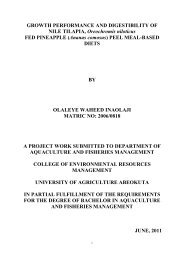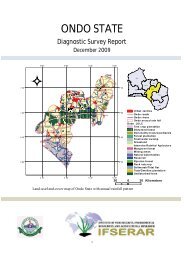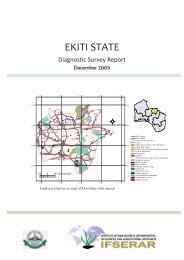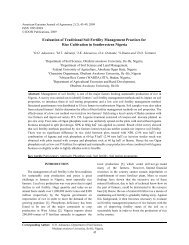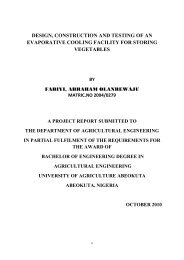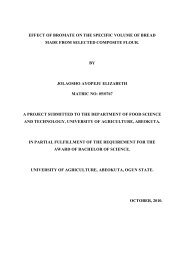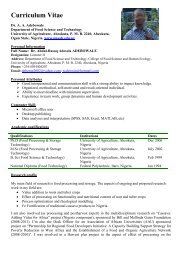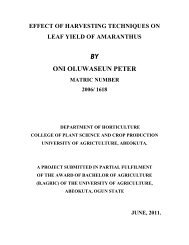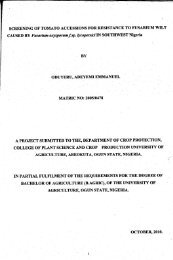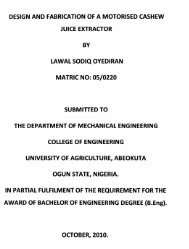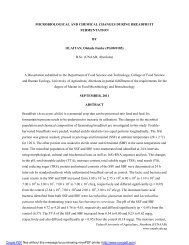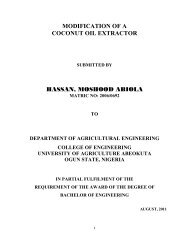UNIVERSITY OF AGRICULTURE, ABEOKUTA OGUN STATE ...
UNIVERSITY OF AGRICULTURE, ABEOKUTA OGUN STATE ...
UNIVERSITY OF AGRICULTURE, ABEOKUTA OGUN STATE ...
You also want an ePaper? Increase the reach of your titles
YUMPU automatically turns print PDFs into web optimized ePapers that Google loves.
<strong>UNIVERSITY</strong> <strong>OF</strong> <strong>AGRICULTURE</strong>, <strong>ABEOKUTA</strong><br />
<strong>OGUN</strong> <strong>STATE</strong>, NIGERIA<br />
IN PARTIAL FULFILLMENT <strong>OF</strong> THE REQillREMENT FOR THE AWARD <strong>OF</strong> THE<br />
DEGREE <strong>OF</strong> BACHELOR IN <strong>AGRICULTURE</strong>
support I have consistently enjoyed from my parents, Mr and Mrs. B. O. Uthman. They are<br />
t<br />
loving parents and it is my prayer that God shall make them enjoy the fiuits of their labor and
This project is dedicated to all farmers who are conscious of sustainable land use thereby preserving<br />
the natural resource for the benefit of generations yet unborn.
5<br />
TABLE <strong>OF</strong> CONTENT<br />
Page<br />
Title page 1<br />
Certification 2<br />
Acknowledgement 3<br />
Dedication 4<br />
Table of Content 5<br />
List of Tables 6<br />
M&~t 7<br />
Chapter One: Introduction 8<br />
Chapter Two: Literature review 10<br />
2.1. Fallow management and soil productivity 10<br />
2.2. Crop-live&ockproduction systems in Nigeria 11<br />
2.3. Tillage practices in Nigeria 11<br />
2.4. Soil Management in relation to upland rice production 12<br />
Chapter 3: Materials and methods 14<br />
3.1. Study area 14<br />
3.2. Field experiment 14<br />
3.3. Soil samplingand analysis 15<br />
3.4. Poultry manure 16<br />
3.5. Crop growth and yieldparameters 17<br />
3.6. Data analysis 17<br />
Chapter 4: Results and discussion 18<br />
4.1 Soil particle size distribution and bulk density 18<br />
4.2 Soil chemical properties and nutrient concentration of poultry manure 20<br />
4.3. Growth of upland rice 22<br />
4.4. Rice yield 24<br />
Chapter 5: Conclusion 25<br />
References 26
6<br />
LIST <strong>OF</strong> TABLES<br />
Table Title Page<br />
I<br />
Surface soil particle size distribution and bulk density<br />
before planting rice in February 2001 in southwestern<br />
Nigeria 19<br />
2 Surface chemical characteristics of unburned and<br />
burned locations at the experimental site in 200 I in<br />
southwestern Nigeria 21<br />
3 Effect of tillage on upland rice height, ground cover<br />
and shoot: root ratio in 2001 in southwestern<br />
Nigeria<br />
4 Effect of poultry manure application on upland rice<br />
23<br />
height, ground cover and shoot: root ratio in 2001 in<br />
southwestern Nigeria 23<br />
5 Growth differences between two upland rice in 200 I<br />
in southwestern Nigeria<br />
6 Paddy rice yields between two upland rice varieties<br />
23<br />
cultivated on a gravelly Alfisol in 200 I at Alahata,<br />
Abeokuta, southwestern Nigeria 24
7<br />
ABSTRACT<br />
Gravelly, coarse-textured soils are prevalent in southwestern Nigeria. These soils are<br />
inherently low in productivity and will require inputs for sustainable crop production. The<br />
management of the soils with low-input technologies for the enhancement of upland rice yields<br />
will lead to poverty and hunger alleviation in Nigeria. Therefore, this study was carried out in the<br />
main campus of the University of Agriculture, Abeokuta southwestern Nigeria in 2001 to<br />
determine the response of two upland rice varieties (ITA 150 and WAB 189-B-B-B-8-HB) to<br />
hoe tillage and poultry manure application at a rate of 15 t/ha. There were three replications<br />
in<br />
the randomized<br />
complete block field experiment. The effects of tillage on rice growth and yield<br />
was obscured by the dominance of sand and gravel in particle size distribution. Although, poultry<br />
manure application had no significant effect on rice growth and yield, it resulted in a paddy rice<br />
yield of 1.7 t/ha which was comparable to expected<br />
yield of rice in Nigeria or under intensive<br />
cultivation. Upland rice cultivation at the site required cover cropping or mulching because<br />
ground coverage by rice at 7 weeks after planting was less than 20%. Significant yield<br />
differences were found between the two rice varieties. The variety, WAB-189-B-B-B-8-HB<br />
yielded 1.3 t/ha while ITA 150 yielded 0.6 t/ha paddy rice. Thus, selection of an adaptable, highyielding<br />
variety such as WAB-189-B-B-B-8-HB and application of poultry manure equal to or<br />
less than 15 t/ha would enhance upland rice production<br />
at the site.
Rice (Oryza sativa L.) is one of the major food crops in the tropics, particularly in Asia.<br />
Its importance as a staple food crop has grown in Africa as indicated by its importation by<br />
various countries in the continent (WARDA, 2000). In Africa, upland rice production constitutes<br />
60% of the total rice-growing areas (Jacquot and Courtois, 1987).<br />
Upland soils in the tropics are generally coarse-textured with low fertility (Lal, 1987;<br />
2000). Although rice is adapted to a wide range of environmental conditions, its production on<br />
the uplands of the tropics require proper management to enhance adequate supply of nutrient and<br />
water. Vigorous growth of any crop under a highly productive soil will lead to profitable yields.<br />
However, soil management is very important in ensuring that even a productive soil gives a<br />
profitable yield since soil productivity is a function of soil physical, chemical and biological<br />
fertility. For instance, a soil containing adequate nutrients may not be productive if it is<br />
compacted.<br />
Manual soil tillage (physical manipulation of soil) and poultry manure application<br />
influence soil physical, chemical and biological properties. These are soil management practices<br />
that low-income farmers growing rice in Nigeria can adopt. Although, the benefits from the<br />
proper use of inorganic fertilizers have been demonstrated over the years, the cost of purchasing<br />
them may be prohibitive or they may not even be easily obtained in a developing nation like<br />
Nigeria.<br />
The gravel concentration and dominance of sand in particle size distribution of soils in<br />
southwestern Nigeria (Lal, 1987) and their hardsetting properties (Ley et al., 1989) indicate that<br />
tillage and the use of organic manure can enhance soil productivity in the region. This hypothesis
9<br />
needs to be tested for upland rice varieties which farmers in the region are likely to adopt
Shifting cultivation is the traditional practice of leaving a degraded agricultural land to<br />
fallow for a period, which in the past could be more than 10 years, so that the productivity of the<br />
soil can be restored (Sanchez, 1976; Ruthernberg, 1980). Although, fallowing is still a practice in<br />
tropical agriculture, the length of fallow has shortened and in some cases farmers virtually crop<br />
their land continuously.<br />
The concept of planted or managed fallow in which the land user intervenes in the choice<br />
and growth of fallow species in order to accelerate soil productivity restoration has been tested in<br />
southwestern Nigeria on degraded Alfisols (Hulugalle, 1992; Hulugalle, 1994; Kang et aI., 1997;<br />
Salako and Tian, 2001; Salako et al., 2001). The results of the various researchers showed that<br />
soil physical fertility was particularly not rapidly restored<br />
of soils was also crucial for sustainable crop production.<br />
and also that post-fallow management<br />
Such post-fallow management practices<br />
include cover cropping, agroforestry, conservation tillage and judicious use of organic and<br />
inorganic soil amendments.<br />
Soil management during cultivation of arable crops is a chief determinant of the<br />
sustainability of agricultural practices. The soil must be productive<br />
for a long time if farmers are<br />
to be prevented from clearing new areas with the consequence of loosing the forest vegetation<br />
which have taken years to grow. Thus, there is a need to maintain the soil at an optimal level of<br />
physical, chemical and biological fertility during crop production<br />
(Lal, 1987). Soils, particularly
11<br />
Alfisols, in southwestern Nigeria are highly vulnerable to soil erosion and this can be
12<br />
nations, manual tillage is practiced and this is done to make raised beds or mounds
13<br />
was a combination of minimum tillage and rice residue mulch. Since the availability of residue<br />
and addition of 15 t 00- 1 farmyard manure can significantly improve millet grain yield in
3.1. Study Area<br />
The study was conducted at the University of Agriculture, Abeokuta (latitude 7.13 N and<br />
longitude 3.28 E), southwestern Nigeria. Mean annual rainfall is 1200 mm and it is bimodally<br />
distributed. The site is a derived savanna<br />
zone and the soil is a gravelly Alfisol.<br />
3.2. Field Experiment<br />
This study was part of an experiment established in January 2001. The experiment was<br />
established as a randomized<br />
complete block design with three replications. The site was cleared<br />
and biomass burned in February 2001. Composite<br />
soil samples were collected at 0-15 cm depth<br />
after biomass burning for soil chemical analyses. Also, poultry manure was collected from a<br />
poultry farm in the vicinity of the experimental site for the experiment.<br />
3.2.1. Plot layout an~Treatments<br />
Each plot size was 3 x 4 m.<br />
Level tillage was carried out with hand hoe on designated<br />
plots. There were also no tillage plots but these were disturbed minimally during land<br />
preparation. Two upland rice varieties, ITA 150 and WAB 189 B-B-B-8-HB, planted on April 5<br />
2001 were considered in this study. These treatments were considered in pairs as follows:<br />
• Poultry manure applied in March at 15 t ha- 1 versus no poultry manure<br />
• Level tillage (15 cm deep) versus no-tillage (except minimum disturbance)<br />
• Rice varieties: ITA 150 and WAB 189
Composite soil samples were taken in February before plot layout, before planting. However, the<br />
site vegetation had been burned by accidental :firethen. Therefore, another location close to the<br />
site but unaffected by :firewas sampled. The composite surface (0- 15cm) soil samples were airdried<br />
and passed through<br />
a 2 mm sieve for particle size distribution and soil chemical analyses.<br />
Also, a fraction of the soil sample was ground and passed through<br />
0.5 mm sieve for organic<br />
carbon determination. "Undisturbed" core samples (0- 6 em) were also taken for bulk density<br />
determination in March after plot layout and tillage. Procedures and methods used for soil<br />
chemical analyses are described by UTA (1979) and Anderson and Ingram (1993) whereas those<br />
used for soil physical properties are described by Klute (1986).<br />
Particle size distribution was determined by pipette method (Gee and Bauder, 198, Sheldrick and<br />
Wang, 1993). Fifty grams of each soil sample was dispersed in a plastic bottle with sodium<br />
hexamataphosdphate<br />
overnight after the removal of organic matter by the addition of hydrogen<br />
peroxide. It was then shaken overnight before being turned into a 1000 ml<br />
measuring cylinder<br />
for measurement with pipette at specified depth related to room temperature. Gravel content of<br />
air-dried soil was measured by collecting gravel retained on 2 mm sieve and weighing it relative<br />
to the total soil weight.
A core sample which was 7 cm deep and 10 cm in diameter was used to take "undisturbed"<br />
core<br />
samples (Blake and Hartge, 1986). This was difficult because of gravel concentration. Soil bulk<br />
density was obtained by taking three core samples from a plot into a large tin. The soil was ovendried<br />
at 10SoC and the bulk density calculated as ratio of dry mass to 3 x volume of core sampler.<br />
Soil pH was determined using 1:1 soil to water ratio and a pH meter. The electrode<br />
of the pH<br />
meter was inunersed in the supernatant. Soil organic carbon was determined using the Walkey-<br />
Black method and total nitrogen using the Kjedahl method. Available phosphorus was<br />
determined by Bray-l method. A flame photometer was used for the determination ofK, Ca and<br />
Na using supernatant obtained by leaching with NILOAC. An atomic absorption spectrometer<br />
was used for determination ofMg and Mn.<br />
A composite sample of the poultry manure passed though O.S mm sieve was analyzed for<br />
concentrations of N, P and K using procedures for plant analyses as described in UTA (1979)
Average plant height for 10 stands of rice was determined<br />
at 6 weeks after planting rice in May<br />
2001. Ground cover by rice was measured using the beaded string method (Sarrantonio, 1991) at<br />
7 weeks after planting (WAP). The method involved marking a string at 15 cm interval and<br />
running it across in two diagonal directions on the rice plot. The number of dots striking a leaf<br />
was recorded for each diagonal. Number of dots striking the leaves divided by the total number<br />
of dots for each diagonal, multiplied by 100 gave to total ground cover for the plot.<br />
At lOW AP, single stands of rice were excavated from each plot. The dry weights of the<br />
aboveground biomass and below ground biomass were taken. From this shoot (aboveground) :<br />
root (belowground)<br />
ratio was calculated for each treatment.<br />
Rice paddy yield was determined in July, at about<br />
16 WAP rice. An inner area of2 x 3 m<br />
was harvested at various times in July due to variation in maturity of rice. The paddy rice was<br />
removed<br />
from the panicles after drying to a constant weight and the yield (weight) per hectare<br />
was calculated.<br />
Soil particle size distribution and chemical properties were described statistically by calculating<br />
means, standard error and ranges. However, analysis of variance (Hinkelmann and Kempthome,<br />
1994) was carried out for crop growth parameters to compare .tillage treatments, poultry manure<br />
treatments<br />
and rice varieties. The least significant difference at 5% probability level was used for<br />
the comparison.
Surface soil at the site was sandy loam at the surface (Table la). Gravel concentration<br />
in<br />
air-dried soil was 466 glkg (± 32 standard error, n = 13 samples). The ranges of values observed<br />
for silt and clay were wide and clay content was low. Low amount of clay and high amount of<br />
sand suggest that the soil would be poor in chemical fertility because exchange of ions in soil is a<br />
function of both the amount and type of clay (Brady and Weil, 1999).<br />
The range of soil bulk density was also wide (Table Ib). This could be attributed to the<br />
small depth of sampling (0-7 cm). The minimum values were observed where surface litter still<br />
existed whereas the maximum values were observed where substantial gravel was sampled with<br />
soil. This could be seen by the observation that the numerical minimum value for the level tillage<br />
was greater than the minimum bulk density in the no tillage plot.<br />
In sampling the gravelly soil<br />
for soil bulk density, there was a tendency to select only spots where core samplers could be<br />
knocked into the soil. This constitutes a bias. Nonetheless, representative samples were taken in<br />
this study as indicated by the range. Management<br />
of the soil at this site for high productivity<br />
would require that the litter layer be protected during cultivation as it complements the low<br />
activity clay in supply of nutrients and structural stability (Salako and Tian, 2001; Salako 2001).
Table 1. Surface soil particle size distribution (g/kg) and bulk density (g/cm 3 )<br />
before planting<br />
rice in February 2001 in southwestern Nigeria<br />
a. Soil particle size distribution (4 composite samples)<br />
Sand Silt Clay<br />
Mean 828 134 38<br />
Minimum 718 93 17<br />
Maximum 872 228 53<br />
Standard error 12.64 40 3<br />
Mean<br />
Minimum<br />
Maximum<br />
Standard error<br />
No-tillage<br />
1.30<br />
0.68<br />
1.76<br />
0.10<br />
Level tillage<br />
1.38<br />
0.81<br />
1.76<br />
0.09
Soil pH increased by 9% due to burning at the site (Tables 2a and 2b). However, the<br />
highest increase due to burning of fallow vegetation was observed with regard to extractable P<br />
while there was no change in exchangeable Mn content. Total nitrogen decreased. The unburned<br />
site (Table 2a) showed that the soil was inherently acidic and low in fertility. Soil organic carbon<br />
is low. The decrease of total nitrogen can be attributed to volatilization which could occur due to<br />
increase in soil pH caused by burning or by direct effect of burning (Brady and Weil, 1999).<br />
Burning of cleared vegetation is a common practice among farmers in the tropics. This practice<br />
leads to<br />
immediate improvement of soil fertility but it is not often sustainable as the<br />
improvement observed is lost after one year of cultivation (Kang et aI., 1997, Salako and Tian,<br />
2001).<br />
Concentration ofN in the poultry manure was 27 g /kg, P was 113 glkg and K was 35<br />
g/kg. For wetland rice production in Punjab, India, Singh et aI. (1987) reported that poultry<br />
manure that contained 18.5 glkg N and 18.1 glkg P was 80% efficient as urea N in terms of N<br />
uptake. Efficient use of N by crop in coarse-textured soil is important, as considerable N<br />
leaching can occur even with application of poultry manure (Sim , 1987). According to Sim<br />
(1987), tillage can encourage the utilization of N from poultry manure. Therefore, it is expected<br />
that nutrient stock at this study site would be improved by biomass burning and poultry manure<br />
application in spite of the coarse texture of the soil.
Table 2: Surface (0-15 cm) chemical characteristics<br />
of unburned and burned<br />
locations at the experimental site in 2001 in southwestern<br />
Nigeria<br />
Descriptive<br />
pH<br />
OrgC.<br />
Total<br />
Brayl P<br />
statistics<br />
(I: I<br />
(glkg)<br />
N<br />
(mglkg)<br />
H20)<br />
(glkg)<br />
Descriptive<br />
pH<br />
OrgC.<br />
Total N<br />
Brayl P<br />
statistics<br />
(1: I<br />
(glkg)<br />
(glkg)<br />
(mglkg)<br />
H20)
Growth of upland rice was not significantly affected by tillage (Table 3). Soil coverage<br />
by rice was poor at 7 WAP and shoot growth was 3 times higher that root growth at 10 WAP.<br />
Lack of significance between no tillage and level tillage was attributed to the fact to soil effect of<br />
the dominance of sand and presence of gravel in particle size distribution (Table 1), which would<br />
cause poor aggregation and low structural stability (Salako et aI., 1999; Salako, 2001). As<br />
indicated in Tablelb, soil bulk density at the surface did not appear too different for the two<br />
tillage practices. Furthermore, the no-tillage treatment could be described as minimum tillage<br />
due to disturbances which made at least the 0-5 cm depth at the site vulnerable to physical<br />
manipulation during land preparation and planting. The vulnerability of the structure of this soil<br />
also implies that additional cover by mulching or cover crop was necessary<br />
with upland rice<br />
cultivation because only about 15% of the soil was protected by rice leaves (Table 3).<br />
Also, application of 15 t ha- l poultry manure did not have any significant effect on rice<br />
growth parameters (Table 4). It was observed, however, that shoot growth of rice was about 1.8<br />
times greater for poultry application than shoot growth for none application whereas it was<br />
almost the same for tillage effects (Tables 3 and 4). This suggests that poultry manure<br />
contributed to shoot growth of rice more than tillage. Nutrients such as N often result in high<br />
shoot: root ratio among other factors such as age of plant and soil physical conditions<br />
(Russell,<br />
1977).<br />
The two upland rice varieties (WAB 189 and ITA 150) had similar growth characteristics<br />
under the tillage and manure application practices<br />
(Table 5). The small difference between the<br />
shoot: root ratios of the two varieties support the deduction that they it was poultry manure<br />
application which boosted shoot growth at the site.
2001 in southwestern Nigeria<br />
Soil amendment<br />
Plant height (em) Ground Cover (%) Shoot: Root ratio<br />
6WAP 7WAP 10 WAP<br />
Poultry 27.9 13 4.4<br />
None 26.9 II 2.4<br />
LSD(0.05) NS NS NS<br />
Nigeria<br />
Upland rice variety<br />
Plant height (em) Ground Cover (%) Shoot: Root ratio<br />
6WAP 7WAP 10 WAP<br />
WABl89 34.5 17 5.3<br />
ITAl50 28.9 15 4.4<br />
LSD (0.05) NS NS NS
Poultry manure application resulted in paddy rice yield of 1.7 t/ha which was not<br />
significantly different from the yield of 0.7 tlha observed for non-application. Significant yield<br />
differences were, however observed, between the rice varieties (Table 6). Jacquot and Courtois<br />
(1987) observed that upland rice yield less than 1 t/ha is often obtained where traditional<br />
methods are used but yield can be as high as 2.5 t/ha in intensively cultivated area but high<br />
variations in yields should be expected for upland rice due to vagaries of climate. Average yield<br />
of paddy rice in Nigeria is 1.7 tIha (WARDA, 2000). From these reports, it is concluded that rice<br />
yields at the present study site could be enhanced by application of 15 tIha poultry manure and<br />
the cultivation of the rice variety, WAB 189-B-B-B-8-HB<br />
Table 6: Paddy rice yield of two upland rice varieties cultivated on a gravelly Alfisol in 2001 at<br />
Nabata,<br />
Abeokuta, southwestern Nigeria<br />
Rice variety<br />
WAB189<br />
ITA150<br />
LSD (0.05)<br />
Paddy rice (tlha)<br />
1.28<br />
0.57<br />
0.475
In this study, the effects of tillage, poultry manure and variety on upland rice growth and<br />
yield were investigated in Abeokuta, southwestern Nigeria. Due to the dominance of sand and<br />
high concentration of gravel in surface soil, there was no response of rice to tillage. Although,<br />
significant differences were not observed for growth parameters and paddy rice yields between 0<br />
and 15 t/ha application rates of poultry manure, the study demonstrated that rice growth and<br />
yield could be boosted with manure application. Paddy rice yield of 1.7 t/ha observed for poultry<br />
manure application is the average expected for upland rice yield in Nigeria. The variety, WAB<br />
I89-B-B-B-8-HB<br />
performed significantly better in terms of paddy rice yield of 1.2 t/ha<br />
compared to 0.6 t/ha for ITA 150. Upland rice production at the site would require nutrient<br />
supply, residue mulchingor cover cropping and selection ofa high yieldingvariety.
Anderson, J. M and Ingram, J. S. L. (eds). 1993. Tropical soil biology and fertility: A handbook of<br />
Methods. 2 nd edition. CAB International,<br />
Wallingford, UK. 221 pp.<br />
Mineralogical methods, ed A Klute, second edition. ASA\SSSA, Madison, Wisconsin, pp. 363-375<br />
Brady, N. C. and Weil, R. R. 1999. The nature and properties of soil. 12 th edition. Prentice-Hall,<br />
Inc. 881pp<br />
""<br />
chemical properties 1989-91. Land Degradation and Rehabilitation 3: 141-152.
Hinkelmann, K and Kempthome, O. 1994. Design and analysis of experiments Volume 1: Introduction to<br />
experimental<br />
design. John Wiley and Sons, New York.<br />
IITA 1979. Selected methods for soil and plant analysis. IITA manual series Nol. International Institute<br />
of Tropical Agriculture (lIT A), Ibadan, Nigeria. 70pp.<br />
Jacquot, M. and Courtois, B. 1987. Upland rice. The Tropical Agriculturalist.<br />
Macmillan Publishers,<br />
London, UK.<br />
Kang, B.T., F.K Salako, 1.0. Akobundu, J. L.Pleysier, and J. N Chianu.1997. Amelioration<br />
of a degraded<br />
Oxic Paleustalfby leguminous and natural fallows. Soil Use and Management 13:130-136.<br />
Kirchhof, G. and Salako, F. K2000.<br />
Residual tillage and bush-fallow effects on soil properties and maize<br />
Intercropped with legumes on a tropical Alfisol. Soil Use and Management 16: 183-188.<br />
Klute, A. (ed.) 1986. Methods of soil analysis. Part 1. Physical and mineralogical<br />
methods. 2 nd edition.<br />
American Society of Agronomy- Soil Science Society of America, Wisconsin, USA.1188pp.<br />
Lal, R. 1975. Role of mulching techniques in tropical soil and water management.<br />
UTA Technical<br />
Bulletin No 1., Ibadan, Nigeria. 38pp.<br />
La!, R. 1987. Tropical ecology and physical edaphology. John Wiley and Sons Ltd., Chichester. 732pp.
28<br />
Nigeria. Journal of Sustainable Agriculture 11: 135-154.<br />
Lal R. 2000. Physical management of soils in the tropics: Priorities for the 21 st<br />
Century ..smL<br />
the tropics. 3 ni edition Clarendon Press, Oxford, Great Britain. 424 pp.
Geoderma 91: 103-123<br />
Salako, F.K., and G. Tian, 2001. Litter and biomass production<br />
from planted and natural fallows<br />
on a degraded soil in southwestern Nigeria. ,Agroforestry Systems. 51: 239-251.<br />
Salako, F.K., S. Hauser, O. Babalola, and G. Tian. 2001. Improvement of the physical fertility ofa<br />
degraded Alfisol with planted and natural fallows under humid tropical conditions. Soil Use<br />
Manage. 17: 41-47.<br />
Sanchez, P. A. 1976. Properties and management of soils in the tropics. John Wiley, New York,<br />
USA. 618 pp.<br />
Sarrantonio, M. 1991. Methodologies<br />
for screening soil improving legumes. Rodale Institute<br />
Research Center, PA, USA. 312 pp.<br />
Sharma, U. C. and Singh, R P. 1998. Nutrient management in rice in the north-eastern<br />
states of<br />
India. International-Journal-of-Tropical-Agriculture 16:. 1-23.<br />
Sheldrick, B. H. and Wang, C. 1993. Particle size distribution. In: Carter, M. R (ed.). Soil<br />
sampling and methods of analysis. Lewis Publishers, Boca Raton, Florida, USA. pp 499-<br />
511.<br />
Sims, J. T. 1987. Agronomic evaluation of poultry manure as a nitrogen source for conventional<br />
and no-tillage com. Agronomy Journal 79: 563-570.<br />
Singh, B., Singh, Y, Maskina, M. S., Meelu, o. P. 1987. Poultry manure as a N source for<br />
wetland rice. International Rice Research Newsletter (lRRI) 12: 37-38.<br />
Smith, G. D., Coughlan, K. J., Yule, D. F., Laryea, K. B., Srivastava, K. L. Thomas, N. P. and<br />
Cogle, A. L. 1992. Soil management options to reduce runoff and erosion on a<br />
hardsetting Alfisol in the semi-arid tropics Soil & Tillage Research 25: 195-215.<br />
Smith, K. A., Brewer, A. J., Crabb, J. and Dauven, A. 2001. A survey of the production and use<br />
of animal manures in England and Wales. II. Poultry manure ..soil Use and Management<br />
17: 48-56.
30<br />
Tarawali, S. A., Peters, M. and Schultze-Kraft, R. 1999. Forage legumes for sustainable



